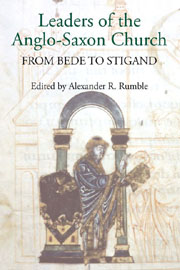Book contents
- Frontmatter
- Contents
- List of Illustrations
- Preface
- Contributors
- Abbreviations
- Introduction: Church Leadership and the Anglo-Saxons
- 1 Bede and the Early English Church
- 2 Archbishop Ecgberht and his Dialogus
- 3 Abbatial Responsibility as Spiritual Labour: Suckling from the Male Breast
- 4 Understanding the Earliest Bishops of Worcester c. 660–860
- 5 The Role of Bishops in Anglo-Saxon Succession Struggles, 955 × 978
- 6 Image-Making: Portraits of Anglo-Saxon Church Leaders
- 7 ‘To Keep Silence Following the Rule's Command’: Bishop Æthelwold, Reforming Ideology and Communication by Signs
- 8 Wulfsige of Sherborne's Reforming Text
- 9 From Winchester to Canterbury: Ælfheah and Stigand – Bishops, Archbishops and Victims
- Index
8 - Wulfsige of Sherborne's Reforming Text
Published online by Cambridge University Press: 05 February 2013
- Frontmatter
- Contents
- List of Illustrations
- Preface
- Contributors
- Abbreviations
- Introduction: Church Leadership and the Anglo-Saxons
- 1 Bede and the Early English Church
- 2 Archbishop Ecgberht and his Dialogus
- 3 Abbatial Responsibility as Spiritual Labour: Suckling from the Male Breast
- 4 Understanding the Earliest Bishops of Worcester c. 660–860
- 5 The Role of Bishops in Anglo-Saxon Succession Struggles, 955 × 978
- 6 Image-Making: Portraits of Anglo-Saxon Church Leaders
- 7 ‘To Keep Silence Following the Rule's Command’: Bishop Æthelwold, Reforming Ideology and Communication by Signs
- 8 Wulfsige of Sherborne's Reforming Text
- 9 From Winchester to Canterbury: Ælfheah and Stigand – Bishops, Archbishops and Victims
- Index
Summary
WULFSIGE, bishop of Sherborne, sometimes identified as Wulfsige III because there were two other bishops of Sherborne by this name in the late ninth and early tenth centuries, hardly springs to mind when we think of the leaders of the Anglo-Saxon church. Yet Sherborne is the only see outside the three leading centres of Winchester, Worcester and Canterbury to have been changed from a clerical to a monastic foundation in the Benedictine reform period, despite the propensity during the ascendancy of the reform to appoint bishops from the community of monks. This momentous event, which appears to have been achieved by Wulfsige's episcopal fiat, occurred in 998. In this respect, what happened at Sherborne was more akin to the instantaneous change achieved by Æthelwold in Winchester than the gradualist approach in Canterbury and Worcester, although there is no indication that Wulfsige adopted Æthelwold's aggressively confrontational methods. He had been consecrated probably in 993 and there is some evidence, in addition to the lapse of time, which suggests that he planned for the change. Yet it was a radical step to take, not matched anywhere else, and it was carried out, apparently successfully, by a man who was at the heart of the reform tradition. So there is perhaps some justification in including him among the leaders of the church.
- Type
- Chapter
- Information
- Leaders of the Anglo-Saxon ChurchFrom Bede to Stigand, pp. 147 - 164Publisher: Boydell & BrewerPrint publication year: 2012

